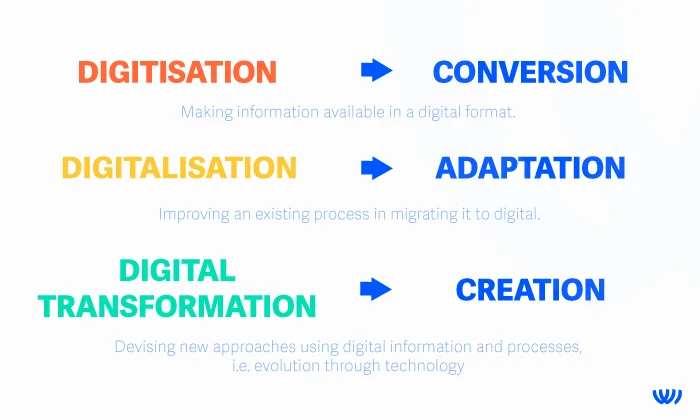What is digitalisation?
To understand the term, consider the relationship between the terms ‘digitisation’, ‘digitalisation’, and ‘digital transformation’:
- Where digitisation is the process of converting information from physical to digital formats,
- digitalisation goes a step further to leverage digitisation and improve processes, e.g., having a positive effect on speed, simplicity and accuracy.
- Digital transformation is a logical result of digitalisation where the evolution of digital processes leads to new ways of working.
Image: To understand each term – digitisation, digitalisation, and digital transformation – consider the relationship between the three definitions.
Why is digitalisation important for your small to medium size business?
Digitalisation, or adapting to digital technology, is improving lives at home and at work. The speed of communication and the immediacy of connectedness is making things easier. Your latest Amazon delivery, Uber, or text from your GP should put paid to any debate. If not, consider the World Economic Forum’s finding that, “70% of new business value over the next decade will be through digitally enabled platforms.” ¹
Large organisations are progressing with digital adoption and many small to medium size businesses are following suit providing their customers and staff with improved, digital experiences. To a large degree, these improvements revolve around speed and ease-of-use. Automation using data and software is allowing us to eliminate repetitive tasks and focus on value. Generally, consumers are becoming increasingly comfortable dealing with big brands in the digital realm. So, it seems, in terms of efficiency and remaining competitive, digitisation and digitalisation are becoming important exercises.
How do I start digitalisation in my business?
Digitalisation is as much about project management as it is deciding on technological solutions, i.e., the plan is as important as the tools. Here we’ll touch on an approach to digitalisation rather than getting mired in notes on code, software, and architecture strategy:
Keep it simple
Just as every business is different, every migration plan will be different. Every small to medium size business will have different sets of resource and operational limitations which will dictate how they need to approach a fundamental shift towards being a digital business. Start with quickly drafted high-level plan, and redraft until your team is satisfied.
Plan with your people
Change management is the key. To introduce changes which will affect a whole business requires preparation, support, and help for individuals, teams, and the organisation as a whole. Planning and incremental change need to be understood, endorsed, and reinforced at each of these levels. A project will suffer without the support of stakeholders. The process must include the customer wherever possible.
Communication is positive
A change like a digitalisation project, although sometimes daunting, must be a positive and exciting experience. Negative perception can stall a project. Proper planning should include good communication. Allowing team reviews in the initial planning phase will always facilitate a good experience.
Get small wins
Reviews can also help a business understand itself better and so reveal improvements that can be implemented in parallel with planned digital migrations. These improvements, beyond the obvious win, can boost endorsement and morale, and so propel the larger scale migration programme.
Get bigger wins
A high-level plan should be both thoroughly researched, defining milestones, and still be flexible to adapt to unknowns. Every milestone should be achievable in the short to medium term, but as part of the whole. Without short to medium term success, many migration projects fail and result in semi-adoption or none at all.
Be agile
Agile practices are well documented, so we’ll skip the definition, but the principles are useful and echoed in this article. This is an iterative approach that acknowledges the benefit of the incremental delivery where a large-scale project may suffer from trying to implement a rigid plan. Put simply, if allowed to evolve during implementation, a plan can improve with contact feedback based on testing and/or results.
Stay calm
A successful project should seem to end without fanfare – the culmination of several milestones achieved where all stakeholders have moved from old processes to new without any undue fuss. Of course, change includes pain points, but good planning and communication will ensure ‘all hands are on deck’ to manage those difficult changes with calm.
A strong plan, message, and team will get there in the end.
Williamson's digitalisation services
If you need help with digitalisation, use our chat service or contact form and we’ll get back to you immediately to explain how we can get your started.
References
- World Economic Forum (July 2020) Digital Transformation: Powering the Great Reset. Available at: https://www3.weforum.org/docs/GITR/2012/GITR_Chapter1.11_2012.pdf (Accessed: 26 January 2023).







